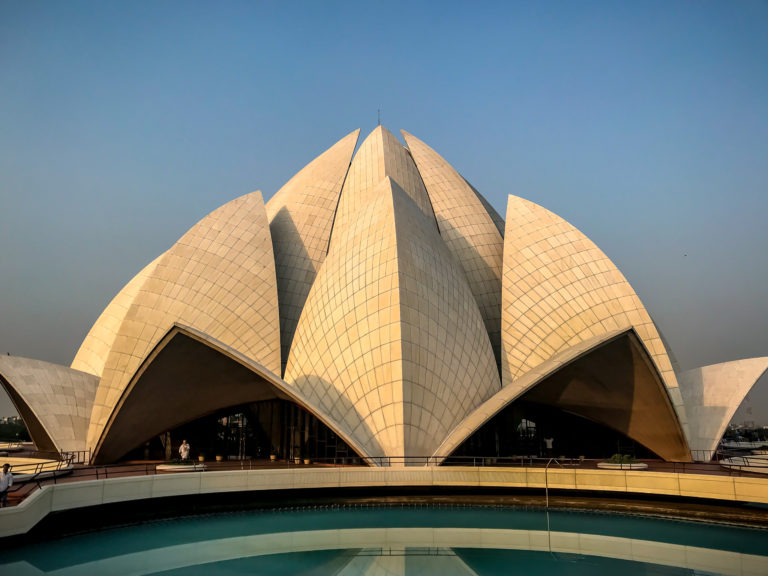Last updated on 07 February, 2019 at 03:35 am
Indian capital, New Delhi offers more than just a glimpse of what the country has to offer: people everywhere, smells, garbage, excellent food, a beautiful architecture mixing oriental style with colonial style, you find everything, in abundance and even more than that.
New Delhi was our first city in India. Since we were in Egypt just before, the cultural shock was smaller but still present. Indeed, we were already a bit used to horns and traffic in Cairo, but nothing prepares for so many noises, smells, dirt and colors. We can easily imagine what a Westerner who comes directly to India feels like.
Our travel tale.
Our arrival in India
We took a Saudi Airlines flight from Cairo to New Delhi with a stopover in Jeddah. It is interesting to note that Saudi Airlines puts a prayer on the journey before each flight.
Jeddah Airport is the closest to Mecca and pilgrims travel through it on their arrival or departure. We came across many groups returning from their pilgrimage and wearing the burka.
For passengers in transit, no need to wear the Burka, you just have to pay attention to wear long sleeves and long pants, easy thing given the freezing temperatures in their airplanes and airports due to air conditioning fully engaged.
For the second flight, it was a low-cost Turkish airline operating a Saudi Airlines plane. When we got on the plane, we were upgraded to “business class”. I put it in quotes because although we sat on business class seats, the service was the same as for the rest of the plane. We were almost only non-Indians. It was only by taking our flight from India to Bangkok that we understood and appreciated our upgrade at its fair value. But that’s another story.
Upon arrival in New Delhi, we were very surprised.
The airport of New Delhi is modern and very clean, more than Cairo’s and especially more than Jeddah’s. Until now, at the exit of the terminal, we were used to a taxi horde waiting for us and proposing overrated prices. Here, practically no one is waiting and we got no transport proposal. I must admit that we were very surprised because we were expecting something completely different.
We then went to the subway well indicated at the exit of the terminal.
It was while searching our way on the metro map that we had our first scam transport proposal, but nothing unusual. Either a shuttle or even a shared taxi would be cheaper than the subway. We decline and buy our ticket at the ticket desk next door. From the airport, an express metro to the city center will cost you 60 rupees per person (0.80 CHF or 0.70 €). This subway is also modern and fast. In about 30 minutes, we are in the city center.
In order to get to our hotel, we had to take a second metro ticket. The price of the metro in the city depends on the destination. Our will cost 20 rupees per person (0.27 CHF or 0.23 €). This second metro is a little older but is quite the road.
In total, our trip from the airport cost us 160 rupees (2.20 CHF or 2 €) while the hotel offered to pick us up for 600 rupees (8.40 CHF or 7.50 €). When we told them we were doing it ourselves, they said we should be careful about scams.
At the subway station, while looking for which exit from the station we had to take, an Indian man stops next to us and asks us if everything was fine.
We explain to him that we are just looking for the exit to go to our hotel, he replied by telling us the way to get to the nearest police station, to ask our way there and not to trust anyone on the way.
Ok … that’s an introduction to India.
Using Google Maps, we find our way quite easily and arrive at our hotel.
The hotel has a travel agency. It was therefore a must after check-in.
They inform us that we are the first to arrive safely by taking the subway (it surprises me that we are the first as we found it was so easy). The day before, a Spanish couple took a rickshaw which dropped them off at another hotel and they had had a hard time getting to the right hotel.
Ok … that’s an introduction to India, 2nd chapter.
The agency offers tailor-made tours with private drivers.
In order to test the concept, we booked for the next day a driver to visit New Delhi for 1’000 rupees (13.60 CHF or 12 €). Although much more expensive than if we had taken the metro, it was a quick and easy way to visit the main sights of the city.
Our visit of New Delhi
The next day at around 9am, we meet our driver in the lobby of our hotel and we leave to visit the city.
Red Fort of New Delhi
Located north of the city center, built with red stones from which it takes its name, the fort is a huge complex composed of palaces, rooms and mosques, surrounded by walls and towers.
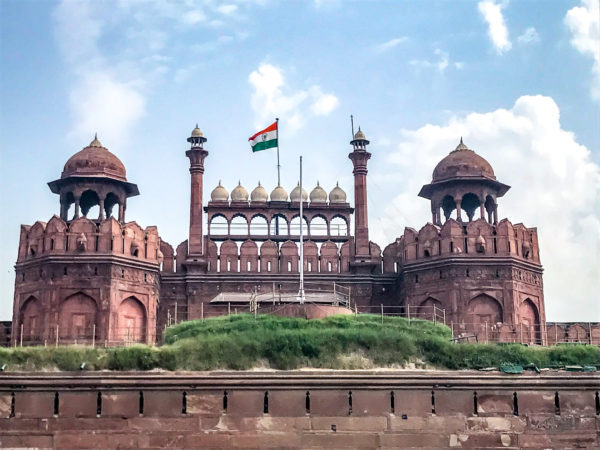
We start the tour from the car park and walk about 5-10 minutes to the main entrance of the site.

The ticket office to buy the tickets are located below the main floor. We head to the foreign counter. The price is well displayed, 50 rupees (0.70 CHF or 0.62 €) for Indians, 600 rupees (8.50 CHF or 7.50 €) for foreigners, 550 rupees (7.70 CHF or 6.85 €) if you pay by credit card.
Yes, there is a price factor greater than 10 between Indians and foreigners.
Yes, it’s cheaper if you pay by credit card (which we did).
We then head to the entrance. Our tickets are controlled with a little more attention than those of the Indians, to check if we wouldn’t have taken the local fare. The good point comes just after: there are two queues, one for Indians and one for foreigners and this second one is much shorter. We pay more, but we wait less, that’s already something worth cheering for.
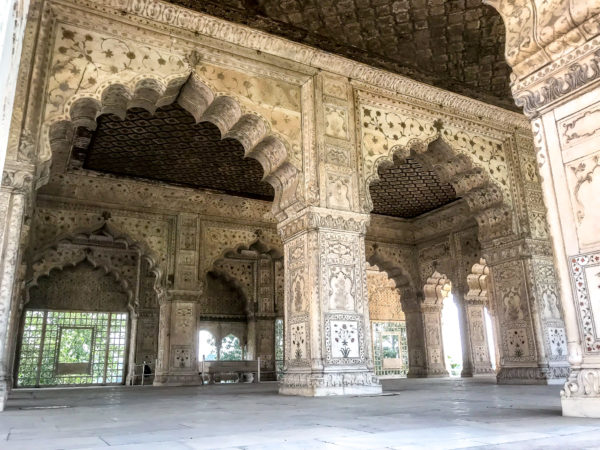
We walk in the complex, letting ourselves be guided by chance.
We take pictures of the different buildings. But we must admit that although it is pretty, no monument really stands out. This leaves us a little on our hunger.
After about an hour to an hour and a half of visit, we walk back to the exit then to our car.
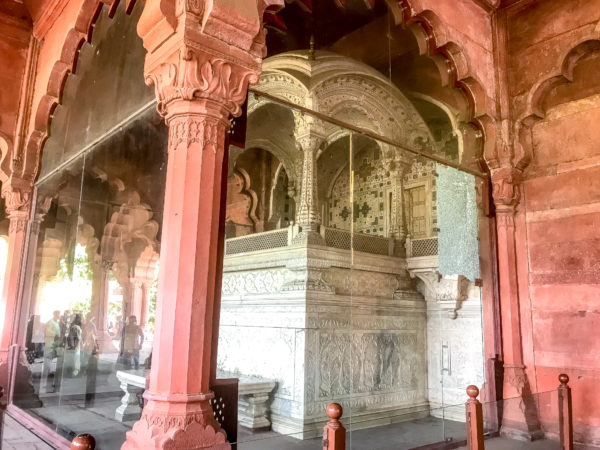
India Gate, President's house & administrative buildings
Aligned on a long avenue, the Indian Gate faces the president’s house. This avenue is one of New Delhi’s main avenue, built with the idea of making military parades on it. Some official buildings are also located along this avenue, right next to the presidential house.
These official buildings are heritages of the colonial period.
President's House and Administrative Buildings
Our driver drives us to the street where the official buildings and the president’s house are located. A few meters from the beginning of the road, a policeman stops us, impossible to go further by car. We will visit the short street by ourselves walking.
Official buildings are located on both sides of the road. The colonial architectural influence can be clearly seen. It isn’t possible to visit the buildings.
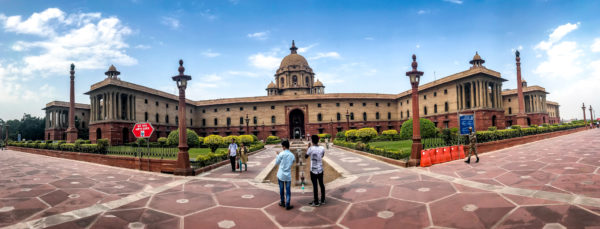
We go up the street to the barrier protecting the house of the president. Here as well, impossible to go closer.
So we turn back and go to our car and continue to the India Gate.
India Gate
Indian variant of the french Arc de Triomphe, you can read on the walls the name of Indian military dead for the Fatherland – understand Great Britain – during the first world war as well as other wars. The flame of the eternal soldier is in the middle of the Gate and indicates the tomb of the unknown soldier.
The tour starts for us at the car park just behind the Gate. We walk then the few meters separating us from the Gate. The hardest part was getting rid of little girls wanting to sell us gadgets and other bracelets.
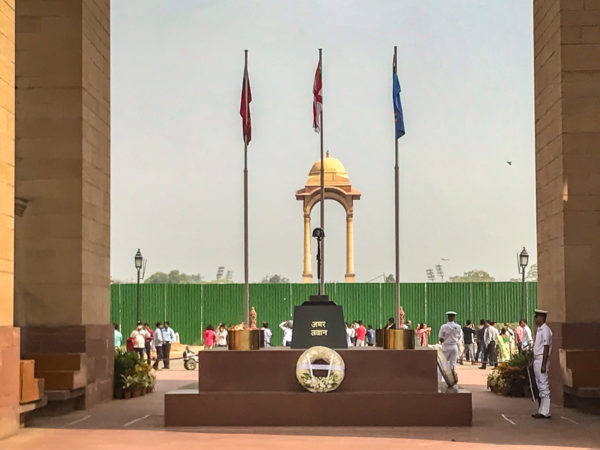
We do some pictures of the Gate and several people ask us to take pictures with them. We didn’t know it at that time but it was the beginning of a looooooooong serie of photos with lots of Indian people during each of our visits.
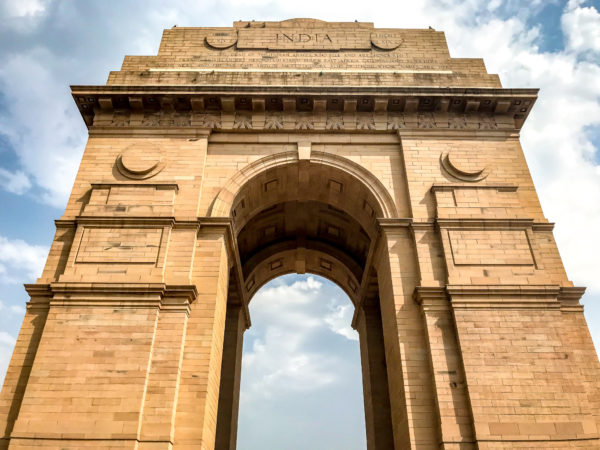
Humayun's tomb
We will then go to Humayun’s tomb. This tomb looks like a mini Taj Mahal. Indeed, the architecture of Taj Mahal is inspired by the one of Humayun’s tomb. Humayun’s Tomb is a test before the masterpiece, a splendid test though! The red marble here replaces the white marble of the Taj Mahal. These two tombs are inspired by the Gour Amir of Samarkand.
Emperor Humayun and 150 members of the royal family are buried in this jewel of Mughal architecture.
The queue to enter the complex is quite long.
I go to see if there wouldn’t be a line for “foreigners paying the expensive price” here too. And indeed, this line is also present, so we pass in front of all the Indians and will pay our foreign price without waiting.
We begin the visit by the other buildings of the complex.
Indeed, the complex doesn’t consist only of this monument and includes several other beautiful buildings such as a mosque and the tomb of the barber (yes!!).
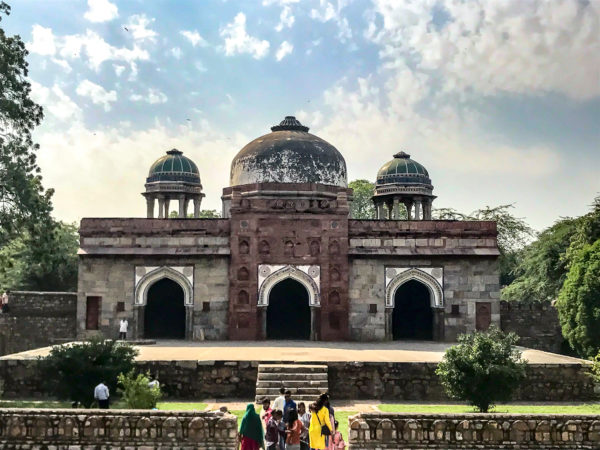
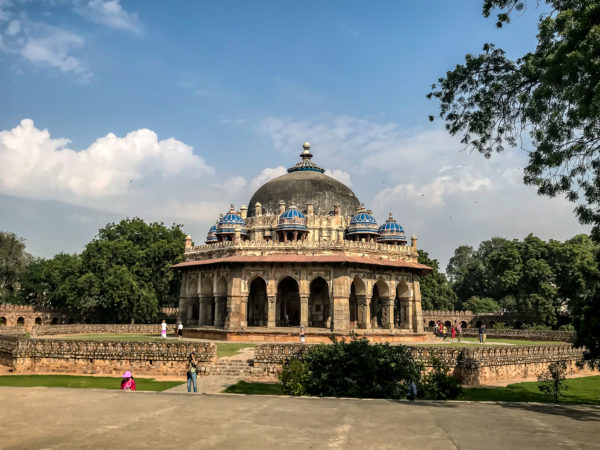
Once we finished seeing the other buildings, we head to the main one, the magnificent red mausoleum. Once the main door is passed, the monument appears in front of us in all its splendor, placed on a base of the same color.
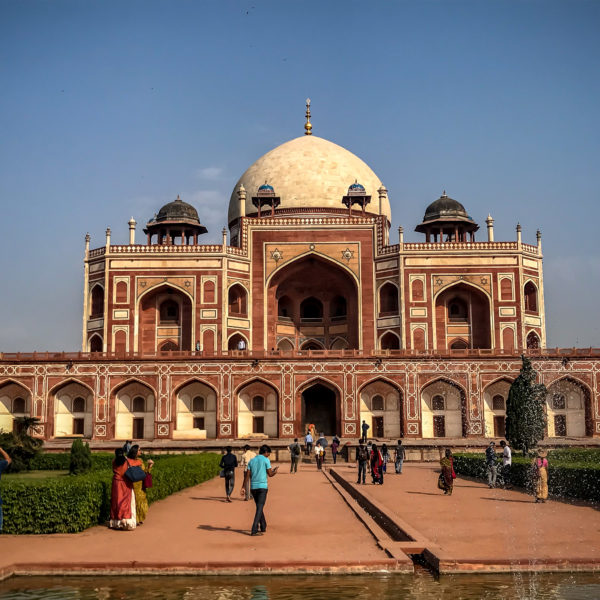
We take photos before continuing and climbing on the forecourt via very steep stairs. The interior of the mausoleum is composed of several rooms barely decorated. The main room contains the sarcophagi of the emperor.
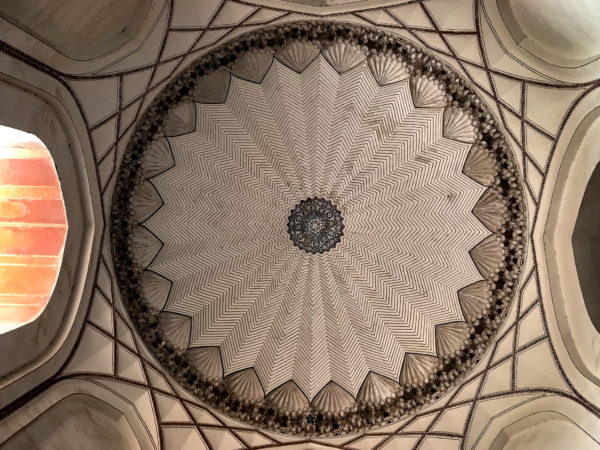
We still turn around the mausoleum before heading to the exit and continue our tour of New Delhi.
The best time to visit Humayun’s grave is in the afternoon, during the golden hour. The sun will illuminate at this time the main red facade giving a beautiful intensity to the monument.
Lotus temple
We were in New Delhi the day before a Hindu holiday. The temple of the Lotus, whose access is free, was therefore invaded by Indian people coming to pray.
It was during this visit that we were able to experience the concept of Indian queuing.
Indeed, Indians don’t queue like we are used to, one behind the other, but rather, as soon as a queue is formed, it’s an opportunity to pass by and create another queue besides the first one. In addition, forget any notion of personal space, the person behind you will stick to you and even, if necessary, push to be sure that no one puts himself between you.
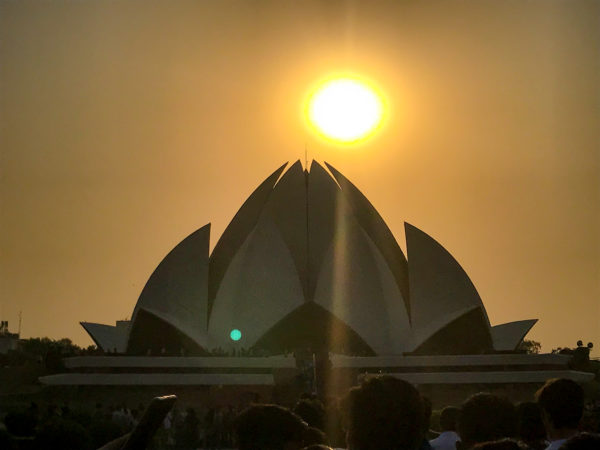
In the shape of a lotus (logical with such a name), up to 1’500 people can fit in the temple. Opened in 1986, the temple is open to any religion.
We didn’t enter the temple but just walked around the building.
The best time to photograph the temple is in the morning, the sun will illuminate the temple on its front side. If you were to visit it at another time of day (like us), be aware that by walking around the building, it is always possible to find a good angle of illumination.
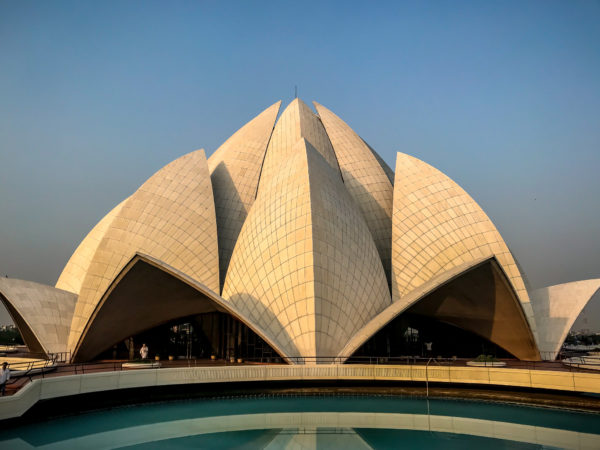
And much more
We finally didn’t have time to visit Qutub Minar, the highest minaret in India and the third in the world.
On the way back, we pass through Connaught Place, a huge roundabout with lots of shops that may deserve a stop if you have time.
What's next for us?
After having visited New Delhi, we left for a 10-day tour in the Golden Triangle, the name given to the route from New Delhi to Agra and Jaipur. We started by visiting Agra where we saw the magnificent Taj Mahal.
We then flew to Bangkok in Thailand to continue our trip.
Practical advices to visit New Delhi
Here below you will find all our tips and advices to visit New Delhi. For our tips on India in general, read our dedicated article. Released soon.
How to get around New Delhi? Transportations
During our day visiting, we hired a private driver. This saves travel time between the monuments.
The Uber app is available in New Delhi and we used it without trouble. There is even a way to pay less by potentially sharing your journey, it’s called UberPOOL. The driver may stop on the way to pick up other passengers who are going in the same direction as you. However, we didn’t test this possibility.
We took the metro from the airport to the city center, to our hotel. The subway seems to work well and is quite cheap.
Where to sleep in New Delhi? Accommodations
We stayed at Hindustan By Backpackers Heaven. We chose this hotel because it’s located between New Delhi Railway Station, from where the metro from the airport arrives, and another metro stop, the Ramakrishna Ashram Marg. The room was comfortable and relatively quiet. The breakfast on the roof of the hotel was a bit minimal.
Where to eat in New Delhi? The restaurants
It is difficult to give advice on the whole city due to its large size.
We mostly ate near our hostel. We were very happy with the Malhotra Restaurant, located a few blocks from our hostel and recommended by them.
How much do the entrances to monuments in New Delhi cost?
Here are the price of entrance tickets per person for the monuments we have visited:
- Red Fort: 550 rupees (7.70 CHF or 6.85 €)
- Humayun’s tomb: 550 rupees (7.70 CHF or 6.85 €)

